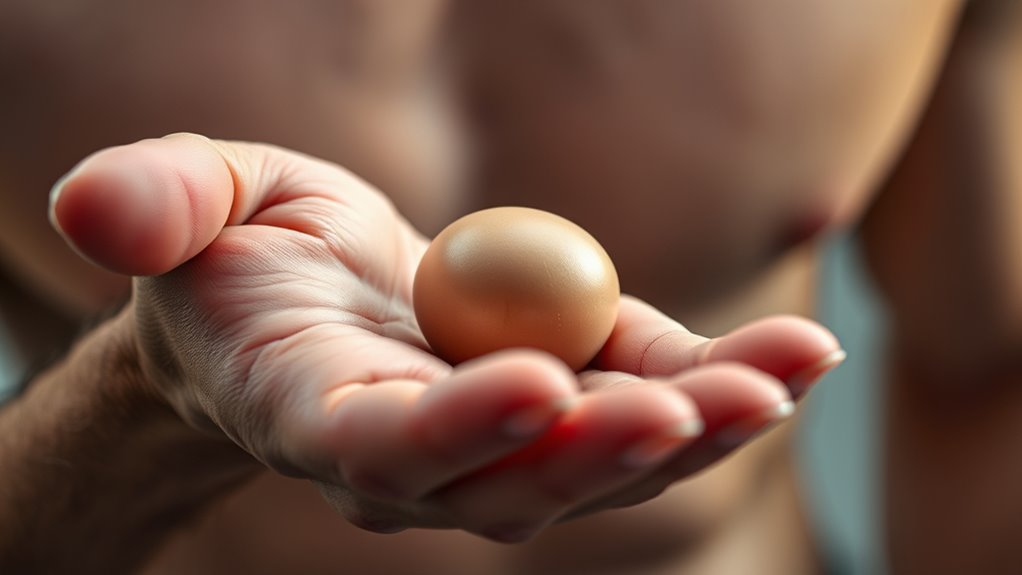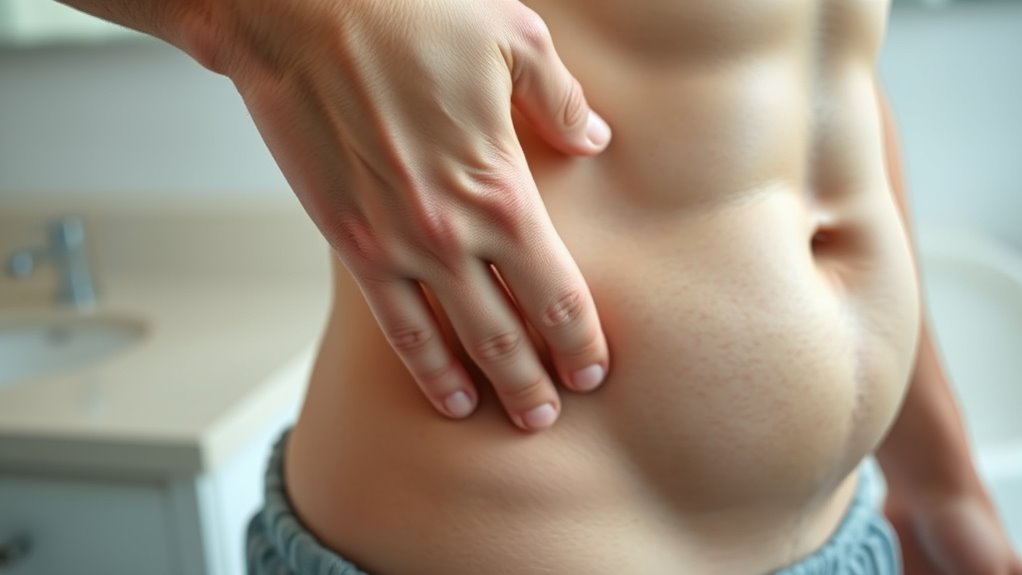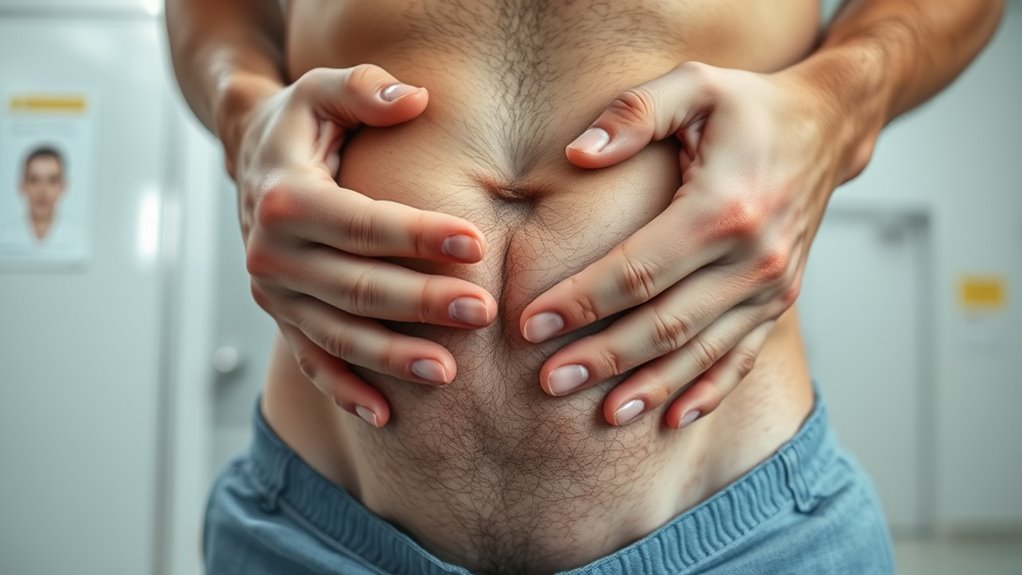To perform a testicular self-examination, use clean hands and look for lumps, swelling, or changes while gently feeling each testicle for irregularities. Do this once a month after a warm shower to relax the skin. Recognizing normal anatomy and understanding warning signs helps you catch issues early, including testicular cancer. Consistent checks improve awareness and health outcomes. Stay with us to learn how to master the technique and stay proactive about your reproductive health.
Key Takeaways
- Use clean hands and perform the exam during or after a warm shower to relax the scrotal skin.
- Gently roll each testicle between thumb and fingers to feel for lumps, irregularities, or swelling.
- Familiarize yourself with normal testicular size, shape, and texture to detect abnormalities early.
- Regular monthly self-examinations help identify persistent lumps, swelling, or pain for timely medical consultation.
- Early detection of abnormalities significantly improves treatment outcomes and prognosis for testicular health.
Understanding the Importance of Testicular Self-Examination

Understanding the importance of testicular self-examination is essential because it allows you to detect potential issues early. Maintaining good testicular health is vital for overall well-being and reproductive function. By regularly checking your testicles, you become familiar with their normal size, shape, and texture. This familiarity helps you notice any unusual changes, such as lumps, swelling, or tenderness, which could indicate a problem. Early detection of abnormalities greatly increases the chances of successful treatment and can prevent more serious health issues down the line. Making self-examination a routine part of your health care empowers you to take control and stay proactive about your testicular health. Regular self-examination also promotes testicular health awareness, which is crucial for early intervention and better outcomes. Developing a consistent routine can improve your ability to identify problematic changes promptly. Incorporating self-examination techniques into your health routine ensures you are prepared to recognize signs of concern early, potentially saving your life. Remember, catching issues early can make all the difference in your treatment options and outcomes.
When and How Often Should You Perform TSE?

You should perform a testicular self-examination once a month to stay familiar with your body. The best time is during or after a warm shower when the scrotal skin is relaxed. Consistency helps you notice any changes early, so set a reminder to keep it part of your routine. Developing an understanding of normal signs and symptoms can help you detect abnormalities more effectively.
Monthly Routine Checks
Performing a testicular self-examination (TSE) once a month helps you become familiar with your body’s normal appearance and feel, making it easier to detect any unusual changes early. Understanding your testicular anatomy is key, as it allows you to recognize normal size, shape, and texture. Hormone effects can influence testicular size and consistency, so regular checks help you notice subtle differences. Consistency ensures you’re familiar with your body’s unique features, which is vital for early detection of abnormalities like lumps or swelling. Performing TSE at a regular monthly interval makes it easier to distinguish between normal variations and potential issues. Regular practice also enhances your self-awareness and confidence in identifying concerning signs early. Make it a routine, and you’ll be better equipped to catch problems early, improving your chances of effective treatment.
Best Time for TSE
Choosing the right time for your testicular self-examination guarantees consistency and accuracy. The best moment is during or after a warm shower or bath when your scrotal skin is relaxed, making it easier to feel for any abnormalities. Perform TSE once a month to align with your body’s natural rhythm, supporting early detection of changes. Understanding testicular anatomy helps you know what’s normal, while hormone regulation influences testicular size and consistency. Regular checks allow you to become familiar with your unique testicular texture and feel, so you can identify any irregularities early. Consistency in timing ensures that you notice subtle changes over time, increasing the chances of catching potential issues early, when they’re most treatable. Recognizing the importance of asset division can help you approach health issues with a clearer understanding of your rights and responsibilities. Being aware of symptoms such as lumps, swelling, or changes in size can help you recognize potential signs of health concerns like testicular cancer.
Preparing Yourself for the Examination

Before you start your testicular self-examination, gather any supplies you’ll need, like a mirror or gentle soap. Find a comfortable, private place where you can relax without interruptions. Set a routine schedule so you remember to check regularly and stay consistent. Incorporating a regular maintenance routine with your self-exams can help ensure effective monitoring of any changes. Being aware of early detection benefits can motivate you to stay diligent with your examinations. Understanding the mechanics of your body, such as how a dual-flush toilet system promotes water efficiency, can also enhance your awareness of health and environmental practices.
Gather Necessary Supplies
To prepare for your testicular self-examination, gather a few simple supplies to make certain the process goes smoothly. Start by guaranteeing your hands are clean with personal hygiene, washing thoroughly with soap and water. Having a mirror nearby can help you see your scrotal area clearly if needed. You might also want a comfortable, private space where you can relax during the exam. No special tools are necessary, but wearing loose clothing can make it easier to access the testicles. Understanding testicular anatomy helps you recognize what’s normal, so take a moment to familiarize yourself with the shape and feel of your testicles beforehand. Being prepared ensures you can perform the examination confidently and comfortably, increasing the likelihood of early detection of any abnormalities. Using essential oils for relaxation in your environment can help create a calming atmosphere during your self-exam. Additionally, being aware of AI discoveries and the advancements in healthcare technology can inform you about new tools and methods available for health monitoring. Incorporating sound healing science concepts like calming sound frequencies can also help reduce anxiety during the process.
Choose Comfortable Setting
Selecting a comfortable setting is essential to perform a thorough and relaxed testicular self-examination. A comfortable environment helps you feel at ease and promotes a relaxed mindset, making the process more effective. To prepare, consider these steps:
- Choose a quiet, private space where you won’t be disturbed.
- Ensure the room temperature is comfortable to avoid discomfort during the exam.
- Set aside enough time so you won’t feel rushed or anxious.
- Incorporating mindful decluttering techniques can help reduce distractions and create a more focused environment for your self-exam. Being aware of self-care practices can further enhance your comfort during the process.
- Taking a few moments to practice relaxation techniques before starting can help ease any tension and improve your focus.
Creating an environment where you feel safe and relaxed allows you to focus fully on the examination. This mental state helps you notice any changes or abnormalities more clearly, increasing early detection chances. Remember, a calm and comfortable setting is key to a successful self-exam.
Establish Routine Schedule
Establishing a routine schedule for testicular self-examination helps guarantee you check regularly and detect any changes early. Setting consistent schedule reminders, like monthly alarms or calendar alerts, keeps self-exams on track. Involving family members can provide support and encouragement, making it easier to remember. Creating a specific day each month, such as the first Sunday, helps build a habit. Use the table below to organize your approach:
| Action | Reminder Method | Family Involvement |
|---|---|---|
| Schedule check | Phone alarm or calendar | Ask a partner or family member to remind or check in |
| Set reminders | Repeating notifications | Share the schedule with loved ones for accountability |
| Consistency | Monthly routine | Encourage family participation for support |
Maintaining a consistent routine can also help you stay informed about sector performance metrics and emerging trends across industries, which can be valuable for overall health awareness and proactive management. Regular self-examinations can also lead to early detection of testicular cancer, significantly improving treatment outcomes and early detection can save lives.
Step-by-Step Guide to Performing TSE

Performing a testicular self-examination (TSE) regularly is an important step in detecting early signs of testicular cancer. It helps you stay aware of your testicular health and boosts self-awareness. To perform TSE:
- Warm up and find a comfortable, quiet space. Use your fingers to gently roll each testicle between your thumb and fingers, feeling for lumps or irregularities.
- Check the epididymis and cord. These are normal structures, but familiarize yourself with what they feel like.
- Inspect for swelling, tenderness, or changes. Note any unusual lumps, firmness, or size differences.
- Be aware of the importance of early detection and self-awareness in managing your health. Making TSE part of your routine helps you recognize normal testicular anatomy, keeping you proactive about your health.
- Understanding AI safety and continuous monitoring of health data can enhance early detection strategies.
Recognizing Normal Testicular Anatomy and Variations

Understanding what your testicles normally feel like is key to identifying any changes during self-examinations. Testicular anatomy varies slightly from person to person, but generally, each testicle is oval-shaped and smooth. They are usually about 1.5 to 2 inches long and feel firm but not hard. You may notice slight anatomical variations, such as differences in size or the presence of small, soft cords called epididymis, which are normal structures responsible for sperm storage. The scrotum’s skin can also differ in texture and tightness. Familiarizing yourself with these normal features helps you distinguish between typical anatomy and potential issues. Remember, normal testicular anatomy includes some natural variations, and understanding these helps you perform more effective self-examinations.
Identifying Abnormalities and Warning Signs

Being able to spot abnormalities early can make a significant difference in addressing potential health issues. Pay attention to signs like:
Early detection of testicular issues is crucial—look for signs like swelling, lumps, or pain.
- Unusual testicular swelling or a lump that feels different from normal tissue.
- Persistent testicular pain or discomfort, which may come and go.
- Changes in size, shape, or consistency of your testicles, such as firmness or hardness.
These warning signs can indicate problems like infections, cysts, or even tumors. Swelling that persists or pain that doesn’t resolve warrants closer examination. Remember, early detection is key to effective treatment. Regular self-examinations help you become familiar with your body and make it easier to notice any abnormalities or warning signs promptly.
What to Do If You Detect Something Unusual

If you notice any unusual changes during your self-exam, it’s important to take prompt action. Don’t ignore or dismiss these signs—schedule a medical consultation as soon as possible. Early detection can make a significant difference, so seek professional advice promptly. It’s normal to feel worried or uncertain, so consider reaching out to trusted friends or family members for emotional support. They can help you process your feelings and encourage you to see a healthcare provider. Remember, healthcare professionals are experienced in evaluating testicular changes and can determine if further tests or treatment are needed. Acting quickly not only ensures peace of mind but also helps catch potential issues early, increasing the chances of effective treatment. Stay proactive and prioritize your health.
Tips for Making TSE a Regular Habit

Establishing a routine can make testicular self-examination (TSE) a consistent part of your health care. To build this habit, try these tips:
Creating a routine for testicular self-exam helps make it a regular, stress-free part of your health care.
- Pick a specific time each month, like after a shower, when your body is warm and relaxed. Using mindfulness techniques can help you stay focused and attentive during your exam.
- Keep a reminder, such as a calendar alert or note, to reinforce your commitment.
- Seek emotional support from a partner or trusted friend if you feel anxious. Sharing concerns can ease worries and motivate you to stay consistent.
Frequently Asked Questions
Can TSE Detect All Types of Testicular Cancer?
Testicular self-examination helps you spot a testicular lump early, but it can’t detect all types of testicular cancer. Some cancers may not cause noticeable symptoms or lumps, especially in the early stages. You should stay aware of other cancer symptoms like pain or swelling. Regular exams are valuable, but seeing a doctor for any concerns guarantees proper diagnosis and treatment, as not all cancers present with obvious signs.
Does TSE Require Any Special Equipment or Clothing?
Think of TSE as a simple tool in your hand, needing no fancy gadgets. You can perform it comfortably in your own space, wearing loose, comfortable clothing. You don’t need a mirror or a razor—just your fingers and a gentle touch. The process is straightforward, and you can do it in your bathroom or bedroom whenever it suits you. It’s a quick check that could catch issues early.
Are There Any Risks or Side Effects From Performing TSE?
Performing TSE generally has minimal risks, but it can cause psychological impact if you become overly anxious or worried about false alarms. You might notice benign changes that aren’t serious, leading to unnecessary concern. However, regular self-examination helps you become familiar with your body, making it easier to spot real issues early. Remember, if you find something unusual, consult a healthcare professional to avoid unnecessary stress or false alarms.
How Accurate Is TSE in Early Cancer Detection?
Testicular self-examination (TSE) can be quite effective in early cancer detection, but its accuracy depends on your knowledge of testicular anatomy and recognizing cancer symptoms. You’re more likely to notice unusual lumps or changes early on, which improves your chances of catching cancer early. However, TSE isn’t foolproof, so regular check-ups with your doctor are essential for thorough screening and accurate diagnosis.
Should Teenagers or Young Adults Perform TSE Regularly?
Imagine you’re a young knight in a modern-day quest; regularly performing TSE is your armor against unseen threats. As a teen or young adult, practicing TSE fosters adolescent awareness and promotes health education. It’s recommended because early detection can save lives, and establishing this habit now helps you stay vigilant. So, yes, you should perform TSE regularly, empowering yourself with knowledge and confidence in maintaining your health.
Conclusion
Regular testicular self-examinations can be a crucial tool in early cancer detection, potentially saving your life. While some argue that TSE might lead to unnecessary anxiety or procedures, studies show it often helps catch issues early when treatment is most effective. Making TSE a routine part of your health check-ups can empower you to stay proactive. Remember, early detection isn’t just about awareness—it’s about taking control of your health before problems escalate.









